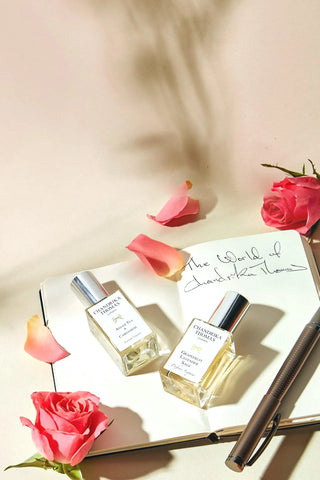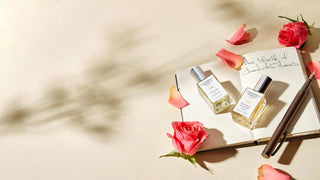For centuries, amidst the ever-changing landscape of fragrance, oud scent has stood against the test of time. A captivating essence derived from the resinous heartwood of the Aquilaria tree, continues to enchant and intrigue perfume enthusiasts around the globe. Its journey spans cultures and continents, from the ancient traditions of the Middle East to the modern ateliers of Paris and beyond.
In this note, we will explore Oud's rich history and cultural significance, uncover its distinctive scent profile, and understand why it has become synonymous with luxury and sophistication in modern perfumery. I know you are curious about the wonders of oud, so let's delve into that and discover its timeless allure.

The Origins of Oud
Oud, also known as agarwood, derives its mystical essence from the heartwood of the Aquilaria tree, particularly species within the Aquilaria genus. This precious resin forms naturally in response to fungal infection, environmental stress, or injury to the tree, prompting a remarkable transformation that imbues the wood with its distinctive fragrance.
Geographically, oud is primarily found in Southeast Asian regions, including Cambodia, Vietnam, and Malaysia, where the Aquilaria trees thrive in humid tropical climates. It is also cultivated in parts of India and across the Middle East, where the resinous wood has been cherished for millennia.
The process of oud formation begins when the Aquilaria tree undergoes a natural defence response, secreting a resinous substance to protect itself from injury or infection. Over time, this resin saturates the heartwood, gradually transforming it into a dense, aromatic material highly prized in perfumery and traditional medicine alike.
Historical and Cultural Significance of Oud
Oud's journey through history is as rich and storied as its fragrance. Across ancient civilisations and modern cultures alike, this precious resin has held a revered place, steeped in tradition and symbolism.
In ancient times, oud was not merely a fragrance but a symbol of prestige and spirituality. Civilisations across the Middle East and Asia recognised its profound significance, using it in various forms:
Egypt and Mesopotamia: Oud resin was utilised in religious ceremonies and rituals, symbolising purification and connection to the divine.
India: Known as "agarwood" or "agar," oud was prized in Ayurvedic medicine for its therapeutic properties, believed to promote mental clarity and spiritual well-being.

Cultural Importance in Various Regions
Middle Eastern Traditions
In the Middle East, oud holds a cherished place in cultural traditions and daily life. It is commonly used:
Perfumery: Oud-based perfumes are deeply ingrained in Middle Eastern culture, worn as a mark of elegance and luxury.
Spirituality: Oud smoke has been historically used in mosques and homes during religious ceremonies and gatherings, symbolising purification and blessings.
Asian Cultural Practices
Across Asia, oud's significance varies across different cultures:
Japan: Known as "jinko," oud is used in traditional incense ceremonies (kōdō), where it is valued for its serene and meditative qualities.
China: Oud, or "chenxiang," is used in traditional medicine and cultural rituals, appreciated for its calming and harmonising effects on the mind and body.
Religious and Ceremonial Uses
Oud's aromatic and spiritual qualities have made it a staple in religious and ceremonial practices:
Islam: Oud is mentioned in Islamic texts and traditions, revered for its association with Prophet Muhammad and used during special occasions and prayers.
Buddhism: In Buddhist rituals, oud incense is burned to create an atmosphere conducive to meditation and spiritual reflection.

The Extraction and Processing of Oud
Oud undergoes a meticulous journey from tree to bottle. Understanding the methods of harvesting, extraction techniques, and the nuances of quality grading sheds light on its esteemed status in perfumery.
Methods of Harvesting Agarwood
The journey of oud begins with the Aquilaria tree, which produces agarwood in response to injury or infection. Harvesting methods vary:
Natural Formation: In the wild, agarwood forms naturally when the tree is infected by fungi or damaged by external forces. This natural process can take decades, resulting in high-quality oud prized for its complexity.
Cultivation: To meet demand sustainably, some regions cultivate Aquilaria trees under controlled conditions, inducing resin formation through controlled fungal inoculation or mechanical means.
Traditional vs. Modern Extraction Techniques
The extraction of oud from agarwood is a delicate art that has evolved over centuries:
Traditional Methods: Historically, oud was extracted using methods that involved soaking, boiling, or steam distillation of the agarwood chips. These techniques require skilled craftsmanship to preserve the aromatic compounds.
Modern Techniques: Today, advancements in technology have introduced more efficient extraction methods, such as supercritical fluid extraction and solvent extraction. These methods aim to maximise yield while maintaining the integrity of the fragrance profile.
Variations in Quality and Grading of Oud
The quality of oud is influenced by several factors, including:
Resin Content: Higher resin content in agarwood contributes to richer and more complex oud fragrance.
Age and Maturation: Oud that has matured for longer periods develops deeper and more nuanced aromas.
Geographic Origin: Oud from different regions, such as Southeast Asia, India, or the Middle East, may exhibit distinct fragrance profiles due to environmental conditions and species variation.
Grading: Oud is often graded based on fragrance intensity, resin quality, and purity. Grades range from artisanal and aged oud (high-end) to commercial grades used in mass-market perfumery.
Understanding these aspects not only deepens appreciation for oud's craftsmanship but also guides perfumers in selecting the finest oud for creating exquisite fragrances.

The Scent Profile of Oud
Oud presents a tapestry of notes and accords that vary widely depending on its origin and extraction method.
Unique Characteristics of Oud Fragrance
Oud is renowned for its deep, complex, and multifaceted scent profile:
Woody and Earthy: At its core, oud exudes rich woody notes, reminiscent of damp forests and aged timber.
Animalic and Musky: Some ouds carry animalic nuances, evoking a primal, musky quality akin to leather or barnyard.
Sweet and Balsamic: Many ouds feature sweet, resinous undertones, offering hints of caramel, honey, or dried fruit.
Differences in Oud Scents Based on Region and Extraction Method
The aroma of oud varies significantly based on where it's sourced and how it's extracted:
Region: Oud from Southeast Asia often leans towards a darker, more smoky profile, while Middle Eastern ouds tend to exhibit a smoother, sweeter character.
Extraction Method: Traditional steam distillation preserves the nuances of natural oud, whereas modern extraction techniques may alter the fragrance profile to emphasise specific notes.

Blending Oud with Other Notes
Oud is commonly blended with a variety of other ingredients to create harmonious and captivating scent experiences. Where the richness of oud intertwines seamlessly with complementary notes, elevating the olfactory experience to new heights.
From the sultry allure of warm spices to the delicate embrace of floral accents, our compositions celebrate the versatility of oud:
Warm Spices: Infusing oud with spices like cinnamon and cardamom adds a comforting warmth and depth, creating an inviting and intoxicating aroma.
Floral Accents: Embracing floral notes such as rose and jasmine enhances the elegance of oud, softening its intensity while adding a touch of timeless sophistication.
Woody and Resinous Undertones: Pairing oud with woods like sandalwood and resinous elements such as amber amplifies its earthy base, ensuring a lasting impression of luxury and refinement.

Oud in Perfumery
Oud has emerged as a cornerstone of modern perfumery, captivating fragrance enthusiasts with its luxurious and evocative qualities. Its popularity has soared in recent years, making it a sought-after ingredient in both niche and mainstream fragrance compositions.
At Chandrika Thomas London, we celebrate the timeless allure of oud through our exclusive collection:
Allure Rose Blossom Oud Perfume: Woven around a sensual rose, this fragrance unfurls like the intricate threads of an ancient tapestry, inviting you into a world where the intoxicating allure of oud dances in harmony with warm wood smoke and a subtle touch of spice.

Allure Rose Blossom Oud Diffuser: Immerse yourself in the irresistible allure of our oud diffuser, featuring rich notes of oud, warm wood smoke, subtle spices, and the indulgent essence of luxurious cognac, all embraced by the delicate presence of sensual rose.
Oud & Patchouli Diffuser: Experience the captivating symphony of Oud and Patchouli, meticulously crafted to mesmerise and encapsulate pure luxury.
Rose Oud Diffuser: Elevate your surroundings with our Rose Oud Diffuser, blending the sweet allure of fresh roses with captivating patchouli and the rich, woody base of cedarwood and oud.

We cannot overlook the undeniable allure and timeless appeal of oud. From its origins rooted in ancient traditions to its modern-day prominence in perfumery, oud stands as a testament to luxury and sophistication.
Surely, it is an experience steeped in history, craftsmanship, and rarity. As we continue to be drawn to its complex and evocative qualities, one thing remains certain: indulging in oud is an investment in an olfactory journey that transcends mere fragrance.
If you haven't yet experienced the enchantment of oud, consider this your invitation to discover your signature oud scent, a fragrance that promises not just scent, but an unforgettable sensory experience.






